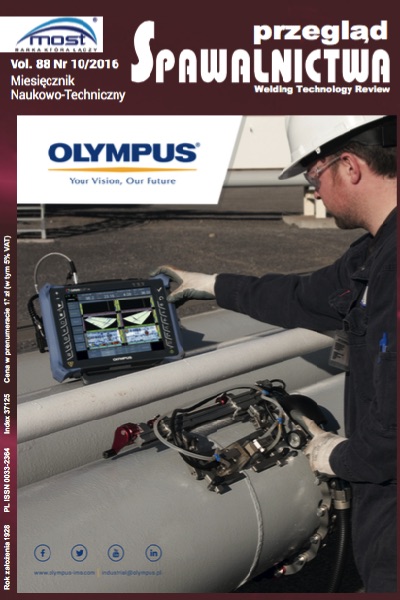Badanie relacji między stanem wytężenia a parametrami impedancji niskoczęstotliwościowej
##plugins.themes.bootstrap3.article.main##
Abstrakt
W artykule przedstawiono wyniki badań własnych oraz wybrane dane literaturowe dotyczące identyfikacji stanu wytężenia materiału przy pomocy niskoczęstotliwościowej impedancji elektromagnetycznej. Przedstawiono motywację badań i podstawy teoretyczne metody. Zwrócono uwagę na niejawny, nieliniowy związek istniejący pomiędzy parametrami mechanicznymi i elektromagnetycznymi materiału a stanem jego wytężenia. Omówiono tor pomiarowy używany w badaniach. Omawianą tematykę zobrazowano przykładami. Na podstawie wyników badań wykazano możliwość stosowania taniego mostka LCR do wiarygodnego diagnozowania stanu wytężenia materiału.
The study of the relationship between the material effort and the low-frequency parameters
Abstract
The results of research and selected literature data concerning the identification of the state of material effort with using low-frequency electromagnetic impedance have been presented in the article. Motivation of research and theoretical foundations of the method are presented. Attention has been paid to implicit non-linear relationship between the mechanical and electro-magnetic properties of material and the effort of the state. Measuring circuit used in research has been presented. Discussed topics illustrated samples. Based on the result of studies it demonstrated the possibility of using low-cost LCR bridge to reliably diagnose the state of material effort.
Pobrania
##plugins.themes.bootstrap3.article.details##
Creative Commons CC BY 4.0 https://creativecommons.org/licenses/by/4.0/
Artykuły czasopisma Welding Technology Review (Przegląd Spawalnictwa) publikowane są w otwartym dostępie na licencji CC BY (licencja Creative Commons Uznanie autorstwa 4.0 Międzynarodowe). Licencja CC BY jest najbardziej otwartą dostępną licencją i uważaną za „złoty standard” w formule otwartego dostępu; jest również preferowany przez wielu fundatorów badań. Licencja ta umożliwia czytelnikom kopiowanie i redystrybucję materiału na dowolnym nośniku i w dowolnym formacie, a także zmienianie, przekształcanie lub budowanie na nim materiału, w tym do użytku komercyjnego, pod warunkiem wskazania oryginalnego autora.
Bibliografia
C.V. Dodd et al.; Some eddy-current problems and their integral solutions; ORNL-4384 raport for U.S. Atomic Energy Commission, Oak Ridge, Tennessee, 1969.
Z. H. Żurek, P. Duka; RLC circuits for material testing and NDT KOMEL, 2014.
B. A. Abu-Nabah et al.; Eddy current residual stress profiling in surfacetreated engine alloys; Nondestructive Testing and Evaluation, Vol. 24, Nos. 12, s. 209232, 2009.
Z. H. Żurek, M. Witoś; Diagnostics of Degradative Changes in Paramagnetic Alloys with the Use of Low Frequency Impedance Spectroscopy 7th International Symposium on NDT in Aerospace, 2015.
J. Gao, M. Pan, F. Luo; Defect Identification and Classification of Multi- Frequency Eddy Current Test Based on Spectrum Method; IEEE International Conference on Information and Automation, 2010.
W. R. Junker, W. G. Clark Jr.; Eddy current characterization of applied and residual stresses; Review of Progress in Quantitative Nondestructive Evaluation, 2B ed. Thompson and Chimenti. Plenum Press, New York, s. 1269-1286, 1983.
Ji-Gou Liu, Wolf-Jürgen Becker; Force and Stress Measurements with Eddy Current Sensors, The 10. International Sensor fairs and Conference, May 8-10, Nuremberg, Germany, vol. II, s. 23-28, 2001.
K. Fryczowski, M. Roskosz, Z. H. Żurek; Preliminary Studies on Impact of Tensile Loads on the Parameters of the RLC Circuit; 44th National conference NDT, 2015; Welding Technology Review, 2015, 87, s. 45-49.
J. Vilysa, V. Kvedarasb; Dislocation Structure of Near Surface Layers of Deformed Low-carbon Steel; 15th Int. Metallurgical & Material Confe- rence METAL 2006.
Welding Guide. Technical Handbook of BÖHLER WELDING Products, Böhler Welding, 2009.
Krysztofik J., Kukla D., So-cha G.:Ocena stopnia uszkodzenia stopu Inconel 718 z zastosowaniem prądów wirowych, Przegląd Spawalnictwa, Vol 87, No 12 (2015).
Kukla D., Grzywna P., Karczewski R.: Ocena rozwoju uszkodzenia zmęczeniowego na podstawie zmian odkształcenia i parametrów prądowirowych w kolejnych cyklach obciążenia, Przegląd Spawalnictwa, Vol 86, No 5 (2014).
